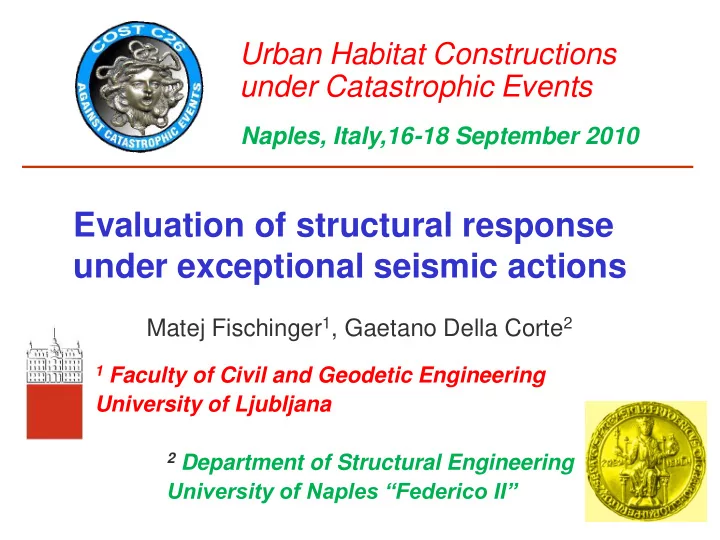

Urban Habitat Constructions under Catastrophic Events Naples, Italy,16-18 September 2010 Evaluation of structural response under exceptional seismic actions Matej Fischinger 1 , Gaetano Della Corte 2 1 Faculty of Civil and Geodetic Engineering University of Ljubljana 2 Department of Structural Engineering University of Naples “Federico II”
Exceptional seismic actions Extreme conditions occur when both loading and structural resistance are combined in such a way to reduce the safety level below acceptable values. This situation may arise either when the loading is larger than expected (foreseen by the codes existing at the time of the design of the structure) or when the provided capacity was lower than anticipated by the modern standards.
Research on structural response under exceptional seismic events To support the development of the PBD procedures As a basis for the seismic risk studies To gain information about innovative structural systems To provide data for seismic rehabilitation of the systems designed prior to the development of modern seismic design principles To enhance the ability of structures to withstand impact and explosion loads
Overview State of the art Contributions from COST members Experimental studies – through collapse Analytical studies RC structures Steel structures Masonry structures
RC structures - Precast structures (contribution from COST members) PRECAST project (Fischinger et al. 2008 , Toniolo 2007 ) Large rotations of columns (up to 10%) Ibarra’s model (2005) was modified at UL Modified Ibarra model
RC structures – Precast structures (contribution from COST members) Risk studies on RC precast structures with strong connections (Fischinger at al. 2008) – PEER methodology Other vulnerability studies on RC structures Kappos (2007)
RC structures - Precast structures (contribution from COST members) How the connections behave in such conditions? SAFECAST project - Response of connections at large rotations of columns Experiments on dowel connections (COST26 final conference – Fischinger et al.) – large rotations
RC structures – Walls (contributions from COST members) Seismic response of lightly reinforced walls - Fischinger et al. 2008 Pushover investigation of 3D Blind prediction wall systems with of the response flexible foundation of 7-story wall, using capacity tested at UCSD spectrum method – Apostolska et al., MVLEM 2008
RC structures (contributions from COST members) Experimental investigation of existing RC buildings sesimically upgraded by means of several innovative techniques (e.g. FRP, eccentric braces and buckling restrained braces) - Mazzolani et al., 2007 Prova di spinta sulla struttura in c.a. 1 2 3 4 5 6 Isolamento con Controventi Controventi Materiali Controventi Pannelli isolatori in ad Compositi Eccentrici con leghe a a taglio gomma instabilità (C-FRP) (EB) memoria di (SSP) (BI) impedita forma (BRB)
RC structures (contributions from COST members) Full scale experimental tests on a real masonry- infilled reinforced concrete two story frame building- Mazzolani et al., 2007
RC structures (contributions from COST members) Modelling of upgraded RC structures (non- ductile mechanisms of the original structure as well as response of strengthen structure): Mazzoalni et al., 2007: advanced model for RC in real masonry infilled building Bordea et al., 2007: modelling of enhacement of ductility of RC columns strengthen by FRP
Steel structures (contributions from COST members) Landolfo et al. 2008: Experimental and analytical studies of typical European steel beams up to severe strength degradation Strength and stiffness degradation was measured in the range of large plastic rotation demand Empirical formulas for characterization of ductility and plastic overstrength were proposed
Steel structures (contributions from COST members) D’Aniello et al. 2008: Tests on buckling restrained braces subjected to large displacements that far exceed the design values Design alternatives were proposed to maximize the brace capacity under the extremly large deformations.
Steel structures (contributions from COST members) Stratan and Dubina 2008: N early full scale tests of eccentricaly braced bare steel frames with removable steel shear links An appropriate detailing of end connections essential for good performance Landolfo et al. 2006, Della Corte et al. 2006, Dubina et al. 2007: Incremental dynamic analysis of different types of steel structures to investigate near-collapse response
Masonry structures (contributions from COST members) Dogariu et al. 2007: Test on masonry pannels under monotonic and cyclic load Results can be used as the baseline to evaluate the effectiveness of the retrofiting interventions Informations can be used for development of the analytical model suitable for analysis of masonry shear pannels up to complete failure
Masonry structures (contributions from COST members) Krstevska et al. 2007: Large scale test of historical mosque with a minaret Test on the original bare masonry model, with a small intensity earthquake to produce small, repairable, damage Tests on the repaired and strengthened model, until collapse of the minaret Tests on the strengthened mosque until collapse. The strengthening systems were based on FRP materials
Masonry structures (contributions from COST members) Two FEM numerical models of the original and strengthen structure FEM models successfully used for the comparison of two structures Calibration with large-scale model steel needed
Masonry structures (contributions from COST members) De Matteis et al. 2008: Experimental and analytical investigations of the cental part of Fossanova gothich church tests on the bare masonry, to produce moderate, repairable, damage; 2) tests on the strengthened model (transverse FRP rods) , until severe damage (close to the collapse) Original structure PGA =0,14g, strengthen structure 0.4g
Conclusions and recommendations (1) Until a decade ago very few experimental and analytical studies of the structural behaviour up to the collapse. Recently the interest has shifted towards near-collapse behaviour. Impressive (full-scale) experiments were performed near to the collapse providing suitable data for the development of the adequate analytical models.
Conclusions and recommendations (2) Empirical calibrated macro-models are prevailing. Although rather simple in concept they provide good physical understanding and consequently good control of the highly complex near-collapse mechanisms. Works performed within the COST C26 action have considerably contributed to these results. Since each collapse mechanism of a particular structural element or structural system is so specific, general solutions are not to be expected. Long term solution is to perform sufficient experiments
Recommend
More recommend